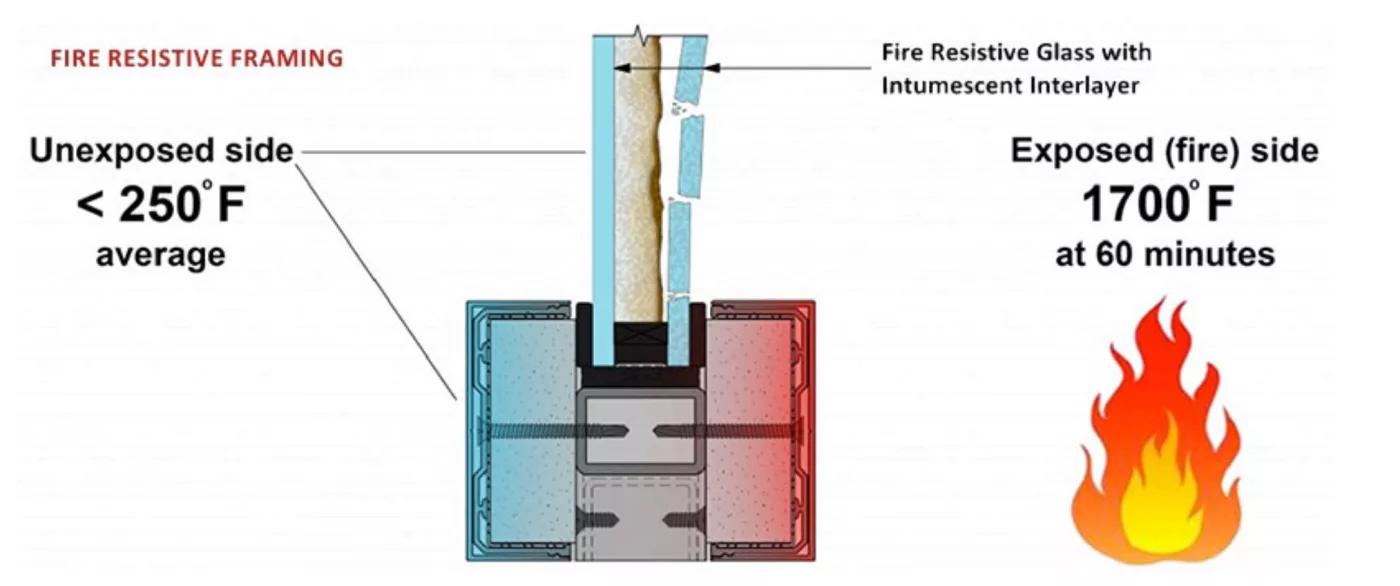Technical Requirements for Fire Windows
I. Standards and Regulations for Fire Windows and Their Components

Fire windows and their corresponding components must adhere to the following standards and regulations:
- “Fire Doors and Windows” – 03J609
- “Fire Windows” – GB 16809-2008
- “Building Wooden Doors and Windows” – GB/T 122-2000
- “Test Methods for Non-Combustibility of Building Materials” – GB/T 5464-1999
- “Fire Expansion Seals” – GB 16807-2009
- “Fireproof Sealing Materials” – GB 23846-2009
- “Code for Fire Protection Design of Buildings” – GB 50016-2006
- “Code for Fire Protection in Interior Decoration Design of Buildings” – GB 50222-1995
- “Code for Fire Protection Design of High-Rise Civil Buildings” – GB 50045-2005
- “Unified Standard for Construction Quality Acceptance of Building Engineering” – GB 50300-2001
In addition to complying with national, industry, and local standards (e.g., those specific to Beijing), all products must meet the fire department’s acceptance criteria. Suppliers are required to cooperate with the fire safety inspection to ensure compliance.Technical Requirements for Fire Windows.
II. Fire Resistance Integrity and Thermal Insulation of Fire Windows
The fire resistance performance of fire windows is crucial in ensuring that they effectively prevent the spread of fire. The required performance standards for fire resistance integrity and thermal insulation are as follows:
- Fire Resistance Integrity:
- Class A: Not less than 1.5 hours
- Class B: Not less than 1.0 hour
- Fire Resistance Insulation:
- Class A: Not less than 1.5 hours
- Class B: Not less than 1.0 hour
For any other requirements not explicitly listed, the fire windows must strictly comply with the corresponding national regulations.
III. Considerations for Chinese Fire Windows
In the context of modern construction, particularly in China, Chinese fire windows and Chinese fire doors are essential components in both residential and commercial buildings. These components not only need to meet rigorous fire resistance standards but also must be aesthetically pleasing and compatible with contemporary architectural designs.
Fire window size allowable deviation
Fire window size allowable deviation Unit is mm
| project | discrepancy |
| Window frame height | ±3.0 |
| Window frame width | ±3.0 |
| Window frame thickness | ±2.0 |
| Two-diagonal length difference of the window frame slot | ≤4.0 |
The allowable deviation of the active sash size Unit is mm
| project | discrepancy | |
| Active window fan height | ±2.0 | |
| Activity window fan width | ±2.0 | |
| Active sash frame thickness | ±2.0 | |
| Active sash diagonal length difference | ≤3.0 | |
| Active sash distortion | ≤3.0 | |
| The lap width of the active sash and the sash | +2-0 | |
Chinese fire doors and windows, particularly those made from steel or wood, are designed to provide robust fire protection while maintaining the structural integrity of the building. Advanced models, such as those featuring aluminum alloy frames or non-insulating fire-resistant glass, are increasingly popular due to their lightweight, aesthetic appeal, and effectiveness in fire scenarios.
The integration of heat-sensitive elements that automatically control the closing of windows during a fire is a significant advancement in the design of China fire doors and windows. This technology ensures that even when windows are left open for ventilation, they will automatically close in the event of a fire, providing an additional layer of safety.
In conclusion, the development and implementation of fire windows in China reflect the country’s commitment to enhancing building safety through stringent adherence to national standards and innovative design features that cater to modern architectural needs. The ongoing evolution of fire window technology, including the incorporation of automated closing mechanisms, represents the future of fire protection in the construction industry.
IV. Additional Technical Requirements for Fire Windows
- Fire Glass Quality:
- The appearance quality of composite fire-resistant glass used in fire windows must comply with the specifications outlined in Table 4 of GB 15763.1-2009. The appearance quality of single-pane fire-resistant glass must adhere to Table 5 of the same standard. The fire-resistant glass should be selected from products that do not compromise the fire resistance performance of the window during testing. The glass’s light transmittance must be no less than 75% of that of an ordinary flat glass of equivalent thickness.
- Window Frame Structure:
- The window frame must be constructed of materials with sufficient strength to ensure the integrity and stability of the components. The frame can be made of steel or wood.
- Steel frames and glazing beads can be made from galvanized steel or stainless steel. The material selection must comply with the specifications outlined in Clause 5.1 of GB12955-2008, which relates to fire doors.
- The filling materials within the steel or wooden frames must be non-combustible.
- Sealing Materials:
- The sealing materials between the frame and fire-resistant glass must be made of flame-retardant materials that can provide fire protection and smoke sealing in the event of a fire.
- Hardware:
- All hardware components must be standardized, tested, and certified for their intended use in fire windows.
- Wind Pressure Resistance:
- The fire windows must have a wind pressure resistance level of no less than Level 4, as specified in Table 1 of GB/T7106-2002.
- Air Tightness:
- The air tightness performance of the fire windows must meet at least Level 3, as outlined in Table 1 of GB/T7107-2002.
- Fire Performance:
- The fire performance of the windows must adhere to the requirements specified in Section II of this document, ensuring both fire resistance integrity and insulation.
V. Installation Requirements
- Acceptance Inspection:
- Upon delivery, the receiving party must carefully verify the quantity, specifications, grade, and completeness of all components against the supply contract to ensure they meet the required standards.
- Storage:
- Fire windows should be stored vertically in a dry indoor environment, with appropriate anti-corrosion measures in place. The glass should be supported and stored in a manner that does not damage its edges or surface.
- Installation Procedures:
- Pre-Installation Inspection:
- Before installation, fire windows must be inspected for any damage or deformation caused during transportation or storage. Any issues, such as warping of the window frame or sash or broken glass, must be repaired before installation.
- Leveling and Alignment:
- During installation, the fire windows must be leveled using a spirit level or by checking alignment with a plumb line to ensure that the window is installed square and level.
- Frame Integration:
- The window frame must be securely integrated with the building structure. It should be anchored to the wall using wooden or metal components. For steel window frames, after installation, the space between the frame and the wall must be filled with cement mortar and cured for at least 24 hours before use.
- Hardware Installation:
- The positions of the hardware installation holes must be accurate, allowing the hardware to be installed securely and flat, meeting operational requirements.
- Glass Installation:
- The gaps around the glass must be uniform. After positioning, the gaps should be filled with fire-resistant cotton and sealed with edging strips.
- Sash Reliability:
- The manual control device for the sash must allow for smooth and complete opening and closing over 100 operation cycles, with no jamming or sticking, and no component detachment or damage.
- Automatic Closing Time:
- For operable fire windows, the sash’s automatic closing time should not exceed 60 seconds.
- Compliance with Construction Standards:
- In addition to the above requirements, the installation must comply with the relevant “Code for Construction and Acceptance of Building Works.”
- Pre-Installation Inspection:
These technical requirements and standards are designed to ensure the safety, reliability, and performance of Chinese fire windows and Chinese fire doors. Compliance with these specifications is essential for achieving the desired level of fire protection in both residential and commercial buildings in China.
